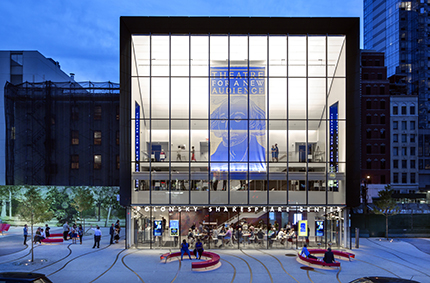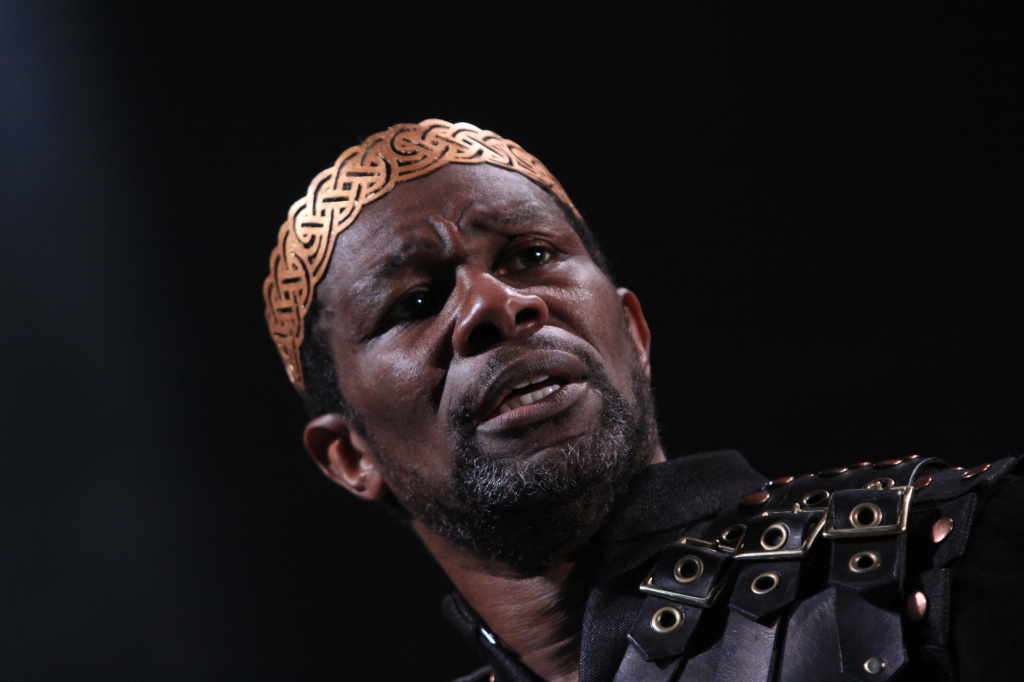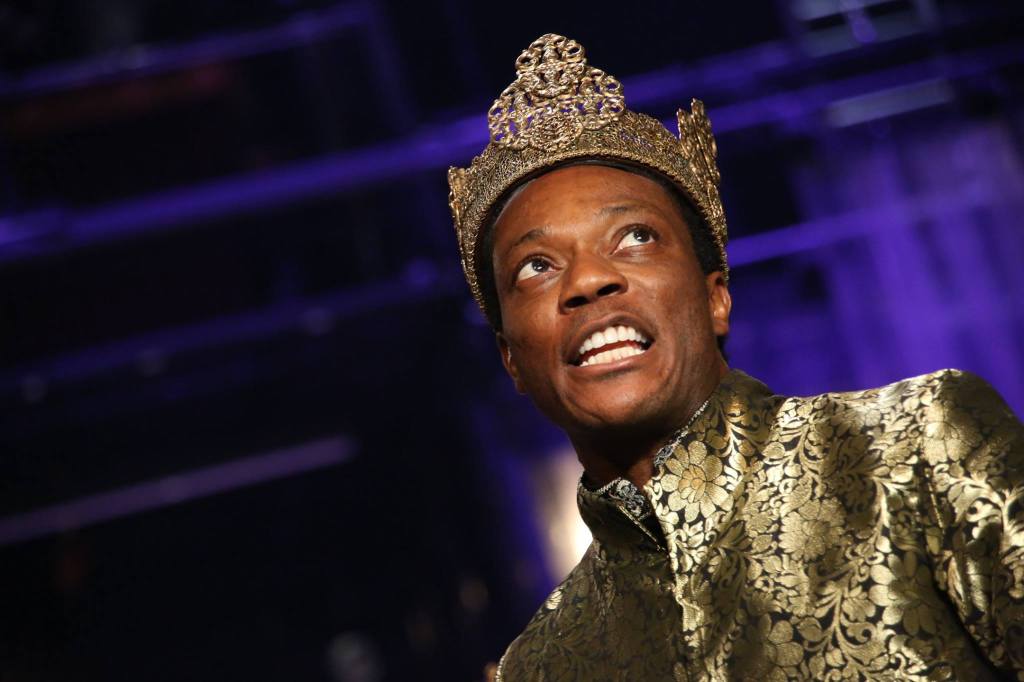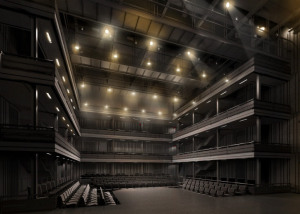The Mask of Blackness: The Arabian Shakespeare Festival’s OTHELLO reexamines Moorishness.
November 15, 2014 § 2 Comments
Otherness comes in many flavors
Since the extinction of the practice of white actors performing (and stereotyping) the title role of Othello in blackface, the play – at least in America – has featured actors of color and become a vehicle for examining black/white race relations. Because that is a necessary, and still unresolved, conversation it has been a highly successful strategy for rediscovering the relevance of the play.
What got lost in that transition is the possibility that Shakespeare was dramatizing otherness and ethnicity, but from a different perspective than Americans are imposing on it because of our current cultural complications: Othello is identified as a Moor, a word more closely associated in the Elizabethan era with those of Arabian descent than with peoples from sub-Saharan Africa. At about the time Shakespeare was writing the play, in fact, Elizabeth was receiving a famous embassy from the Barbary States. The ambassador, who manners and dress captivated London, took time to have his portrait painted.
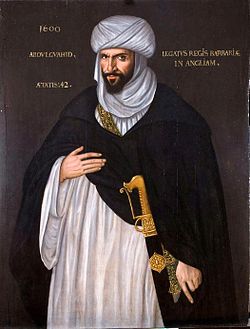
Abd el-Ouahed ben Messaoud ben Mohammed Anoun (Arabic: عبد الواحد بن مسعود بن محمد عنون) was principal secretary to the Moroccan ruler Mulay Ahmad al-Mansur, and ambassador to the court of Queen Elizabeth I of England
The San Francisco-based Arabian Shakespeare Festival is now producing the play in a version which, unsurprisingly given its mission, opens the conversation about the Anglo/Arab implications of the play. The eight-person cast, led by Armando McClain, is mostly composed of accomplished regulars with various troupes in the active Bay Area Shakespeare scene.
The company is an emerging group, still producing on a shoe-string – albeit in an Equity approved project. Performing currently in the Royce Gallery’s intimate space, (the production will later tour to the United Arab Emerates, I think) the set is a modern adaptation of an Elizabethan open stage, cleverly incorporating two large support pillars into the downstage location similarly occupied in the Globe. The scenery, by Janny Cote, consists of a few sliding cubes and a couple of curtains. (These were hung from an incongruously omnipresent palm-ish tree, center stage, which may allude to the symbol of the desert tribes, but because it lacked any direct purpose was – at least to me – confusing.) Joanne Martin’s costumes were suits and uniforms for the male characters, dresses with prominently featured head scarves for the women. The time and place was the modern Middle East.
Performing in an American/Arabian Context
Kevin Hammond’s direction is understated, and as far as creating visually interesting groupings of the actors, essentially absent. The production, therefore, hangs on the performance of the actors, and on the inescapable contemporary implications arising from the company’s American/Arabian context.
On the performance front, the production is an unmitigated treat. In almost any production McClain’s beautiful vocal production and outstanding diction would stand out, but Teddy Spencer as Iago, Jennifer Le Blanc as Desdemona and Artistic Director William J. Brown III as Roderigo easily kept pace. This was far and away the best-spoken production I have recently experienced. For those who go to hear a Shakespeare play, this is what you dream about. The intelligence of the readings, the clarity of thought, and the easy audibility made this production as accessible as any contemporary play. There was never a moment I felt in doubt about what had been said or what was meant.
Spencer’s Iago is especially rewarding. He is a meticulous actor. I previously admired his performance as Orlando in Marin Shakespeare’s As You Like It for its extraordinary clarity, but his Iago is on another plane altogether. The steps by which his plot unfolds, exceeding even his expectations, are so carefully executed that you can feel him thinking in front of you. His Iago is colder than is currently fashionable, which is interesting in the context of Red State America’s xenophobia – he feels no need to seduce us into agreeing with him. Although Spencer is capable of incredible charisma on stage, he does not seek to charm us in this role. Instead, he steadily implicates us in his plot with an expectation that we will share his hatred of the outsider – which is chilling.
Le Blanc is very well known in the Bay Area. Her Rosie-the-riveter-inspired Kate in Taming of the Shrew at Livermore Shakes (opposite McClain as Petruchio) was a powerhouse performance. She is an unusual Desdemona because she is anything but delicate, or helpless. She is a strong actress, and it infuses her characters. Her Desdemona’s fate forces us to think about the issues of women’s rights both domestically and internationally because she is not passively complicit in it. She fights right to the end.
Perhaps the single best performance in the play is Brown’s wonderfully inept Roderigo, whom Iago dupes financially and ultimately murders. From the opening moments he is in over his head, but Brown’s embodiment of his bewilderment, fear, and pliability is a tour de force. It is exceptionally difficult to play weak characters memorably, but Brown’s Roderigo is the best I have ever seen.
Annamarie MacLeod rounds out the principals as Emilia, Desdemona’s servant and Iago’s estranged wife. Emilia has one of the most memorable monologues in Shakespeare, rationalizing why women might cheat on their cheating husbands, but MacLeod delivered it with a vulnerability and yearning for her lost husband that I have never previously seen.
The supporting cast included Malcolm Rodgers, Aaron Kitchin and Sofia Ahmad all of whom had some lovely moments.
A Fresh Context
Conceptually this is not an aggressive production. While the play itself focuses attention on Othello’s outsider status, the implications of the Arabian context in our current climate (where Arab-Americans can be subjected to intense hostility no matter what their religious beliefs or degree of assimilation) unfold subtly and slowly. I, at least, have seen the play so often filtered through the lens of the African-American experience that it took a while to realize exactly how this production was filtered through the American-Arabian lens instead. (There is neither denigration or dismissal of the former in this production, it is simply seen – unusually for our time – through the latter.)
Nonetheless, it gives the play a different feel and focus. For example, near the end of the play Othello receives word that he has been reposted, creating an urgency in his mind to deal with his (in his belief) unfaithful wife before the opportunity passes him by. He might have dealt with things more slowly and rationally if he were not being transferred the next day. And to where? I never really paid attention before, that his transfer is to Mauritania, from which the word for his ethnicity, Moor, is derived. Venice is rewarding his outstanding service by exiling him to a remote outpost where he will “fit in” now that they no longer need him.
Or this: Desdemona introduces the prophetic “willow song” by telling us that her mother’s maid sang it on the night she died. The maid’s name was Barbary – she was Moorish from the Barbary Coast. The number of references to Arabian matters and frameworks is astonishingly high once they are highlighted by design or by context.
Of course, throughout the play many characters (including Othello, himself) also comment on his blackness. This can be understood symbolically, but it has been a long time since I saw an Othello who was not also very dark skinned, so I have hear these references literally instead. (The last Othello I saw who was not very dark skinned was probably Patrick Stewart in a famous “photo-reversed” production for the Shakespeare Theatre in Washington, D.C. in the mid ’90s where everyone else in the cast was African-American.)
I have no idea how Armando McClain self-identifies ethnically, (nor do I think he – or any actor – has any obligation to clarify such matters) but in this production he reads more bronze than black. In this case, that helped me to hear the production as emphasizing the metaphor, the “mask” if you will, of blackness instead of the literalness so often associated with Othello’s and others’ statements. It was useful and interesting to think freshly about the association of darkness with malignancy and the damage done by such connotations.
This is a fascinating and original production of a play which has grown somewhat interpretively stale in the repertoire, and worth the time and effort of anyone that wants to see and hear it with fresh appreciation. It has a short run, and a limited number of seats, so go while the opportunity is available!
Othello
Arabian Shakespeare Festival at the Royce Gallery
Nov. 14, 2014
www.arabianshakespearefestival.org
There Will Be Blood: a review of Marlowe’s TAMBURLAINE, Parts I & II
November 9, 2014 § 4 Comments
Absent Father
Christopher Marlowe was a fast living, young dying contemporary of Shakespeare’s who broke away from the medieval tradition of sing-song alliterative verse and almost single-handedly ushered in the golden age of Elizabethan drama. He was a revolutionary genius, perfecting and popularizing blank verse, a muscular new meter which Ben Jonson called “Marlowe’s mighty line.” He is revered as the “father of English tragedy.” Why, then, are his plays so infrequently produced?
(Doctor Faustus is Marlowe’s best-known work and, I concede, produced more often but still not quite cracking the levels of even minor Shakespeare, but his other plays have essentially dropped from the repertoire in America.)
Although my usual “beat” is the Bay Area, I sought some answers at a recent preview performance in Brooklyn’s Polonsky Shakespeare Center. Theatre for a New Audience is currently offering a rare production of Marlowe’s first great hit, Tamburlaine. How rare? Tamburlaine has not been professional produced in the city during my lifetime, last gracing the boards there in the mid 1950s.
Directed by Michael Boyd (recently stepped down from the helm of the RSC) and starring John Douglas Thompson, the production was illuminating about both the thrill and the danger of reviving Marlowe.
Marlowe’s play, now called Part I, was the hit of the London theatre scene in 1587, and he quickly penned a sequel, Part II. TFANA is presenting a sleek cutting which combines sections from both plays, and bills it as Tamburlaine, Parts I & II. Thoughtful editing by Boyd brought the scope of this evening down to four hours (inclusive of intermission), but that length alone is at least one impediment to more frequent performance. The sheer scale of the material is daunting to both the production company and the audience alike. Whatever compromises were necessary to bring the material down to this length, however, fear of controversy was certainly not a guiding factor as I shall explore a bit more later.
Historical Fiction is not a New Genre
Tamburlaine, like most Marlowe plays, has as its central figure a driven, charismatic anti-hero who refuses to accept the limitations placed on him. Tamburlaine is historical fiction, dramatizing the story of the self-made Tartar Emperor, Timur the Lame, who started life as a poor shepherd and eventually conquered the remnants of Genghis Khan’s empire.
In Part I of the play we watch him rise to power through a combination of fearlessness, charm and treachery, brilliantly conveyed by John Douglas Thompson in the title role.
Tamburlaine is already a successful marauding bandit when the play begins. When the King of Persia (Paul Lazar) sends his disloyal brother (the wonderfully slimy Saxon Palmer) to suppress his piracy, Tamburlaine deftly turns him by elaborately promising to support a coup. Once it is successful, he instantly reneges on his promise by disposing of his new sponsor and taking the crown for himself. (One of the recurrent motifs in Marlowe is the distance between what is said, albeit with rhetorical brilliance, and what is actually done. How depressingly relevant does that remain today?)
It’s All About the Wordplay
He kidnaps the daughter of an Egyptian king, Zenocrate (Merritt Janson) on the way to her wedding, and vows to make her his wife, but delays to test her even after it is clear that she has fallen in love with him. The bulk of Part I is taken with his conquest of the Turks. His verbal duels with Bajazeth, their emperor, (Chukwudi Iwuji giving the best performance in the play) are the high point of the night – Elizabethan trash talk that thrills. Marlowe doubles down on the delight by setting Zenocrate in debate against the Turkish empress (Patrice Johnson Chevannes) in a parallel smackdown.
After Tamburlaine succeeds in his conquest, he tortures the captured Emperor and his wife, by using the former as a footstool and the latter as a household slave forced to watch her husband’s humiliation. Because of the stunning performances it is a degradation that we feel keenly, but accomplished with a theatricality in which we revel. When the formerly arrogant, but downtrodden, couple commit suicide we feel the first stirrings of Marlowe’s tragic capacity.
With striking contemporary relevance, the play is set in a period of intense religious struggle between Christians and Muslims. Thompson is at his best as Tamburlaine when he conveys the warrior’s contempt for the superstitions of both factions – daring everybody’s heavens to strike him down for trampling over anyone in his way.
Boyd’s direction is deft throughout Part I, showing us the brutality of conquest but always avoiding associating it too closely with his protagonist. The most visually astonishing scene of the first act was seeing the assassination of the Persian king, in mid-sentence, as he simply begin to drip blood from multiple wounds invisibly inflicted. It was chilling.
Seneca Redux
It is a play with Senecan levels of violence – again thematically modern but risky. Character after character would die from similarly disembodied causes, or more horrifyingly when a young boy, played by an impassive Ian Saint-Germain, would appear with buckets of blood that he would pour over them. (I strongly suspect that the half-hour intermission was necessary, not because we needed the break, but because that is how long it took to mop up literally gallons of stage blood.)
Part II is more intense, and more piercing in its look at all involved. It begins as the Muslims temporarily ally with the Christians to neutralize the rising protagonist, but (as Tamburlaine knew it would) their truce breaks down. The Christian king is persuaded that he is not bound by his sacred oath because it was given to non-believers. His betrayal is rewarded with almost instant defeat and death, but it gives Tamburlaine the break he needs to divide and conquer.
The focus shifts to Tamburlaine’s training of his three adult sons to succeed him, a lesson in brutality so unrelenting that he kills one of his own sons for insufficient viciousness. It is, significantly, the only murder we see him commit with direct agency and in front of us. The shift of sympathy away from him is palpable, as is our guilt for having been so charmed in the first place. The contemporary implications of the play, that underdogs we consider our allies and have armed can spin out of control once they get the upper hand, becomes inescapable.
Tamburlaine’s rise continues unabated, but its limit is foreshadowed when his beloved Zenocrate dies, despite his order for troupes to attack heaven and prevent it taking her. He turns bizarre as he decides not to bury her, but carry the embalmed body with him on his campaigns. Thompson’s nuanced delivery of his mental decline is brilliant – so carefully and subtly unleashed that we understand how those around him might not have noticed until it was too late.
Cruelty and Swagger
He conquers four more kingdoms, and in the most famous scene in the play, forces their captured kings to draw his chariot. It is this iconic moment, a perfect combination of cruelty and swagger, that made Marlowe’s reputation.
Tamburlaine then attacks Babylon, hanging its governor from the walls and ordering the troupes to shoot him dead for target practice. When a group of virgins is sent by the city to implore mercy he has them impaled, followed by ordering the drowning the entire population of the town, and then ordering their holy book, the Koran, burned – which is performed onstage. (It is that latter point that led me to say that whatever choices Boyd made in cutting the play, avoidance of controversy was not one of them!)
He defiantly denies that any divine punishment will come from it, and it is ambiguous how closely related his final illness is, although its onset begins within a few lines of the desecration. Tamburlaine has died by the end of the scene, unconquered, but leaving behind an empire that will fall apart as quickly as it was built.
The Challenges of Marlowe
What did I conclude after seeing the production? First, Marlowe’s blank verse is muscular, unfashionably so to those who are used to Shakespeare’s more extensive employment of variations. It might be that Boyd’s cutting left too many peaks without enough valleys between them, but it was a difficult to be so constantly attentive to such unrelenting energy. I rather think that Marlowe presents special challenges this way, however.
Second, the themes of the play are amazingly current, but it takes a deft touch to convey them without getting sidetracked into controversy. (For example, can you convince an audience to excuse the burning of a sacred text in front of them, even the pretend burning, by emphasizing the burner was equally contemptuous of all religions? Boyd does, but it is dicey.)
Marlowe is tough – raw and edgy. His plays can be Titus Andronicus-level violent. Set and costume designer Tom Piper and special effects designer Jeremy Chernick emphasized this with white costumes in a basically black Elizabethan courtyard colored only by dripping, splattering, pooling and flowing blood.
Tamburlaine is not particularly sexual, although there is a scene in which one of his generals threatens to rape the conquered woman he loves when she does not return his feelings, but that is exceptional in his plays. Edward II, by contrast, focuses squarely on the homosexual liaisons of the king. And in all of them religious controversy abounds. Marlowe’s atheism is evident throughout this, and other, plays.
The plays present immense logistical challenges to any company without unlimited resources – which is essentially all of them in America. Boyd covers dozens of roles with a cast of twenty, and most of the time the doubling is so thematically motivated that you not only suspend disbelief, but understand the play better because of it. I was a little perplexed by his double casting Zenocrate with the final antagonist Callapine, however, because the actress kept having to leap uncomfortably between the two roles, where all other actors in the production finished each part before moving to the next. A different convention seemed to be employed for her, not altogether successfully, but that is a minor complaint about an overwhelmingly successful production.
Courage and Capability
If I had to state a position, I’d suggest that it is not content that prevents the plays from being produced more often, but difficulty. There are very few companies capable of taking on a Marlowe play.
All the more reason that you should see this production, because TFANA has the courage and the capability! The cast is outstanding, including many actors in lesser parts not singled out above, especially the chameleons Matthew Amendt and Caroline Hewitt. It officially opens this week and runs through Dec. 21.
Tamburlaine, Parts I & II
Theatre for a New Audience
Brooklyn, New York
Nov. 5, 2014


